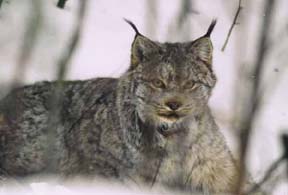Maine trappers will have to comply with additional restrictions on some devices this fall under new regulations intended to protect Canada lynx, a threatened species at the center of a long-running legal dispute.
The Maine Department of Inland Fisheries and Wildlife announced Friday that trappers throughout the state will be required to use special “exclusion devices” on traps set on dry land to keep lynx from getting caught inadvertently in traps designed to kill an animal. The exclusion devices have openings too small for a lynx to access a trap and are designed to preclude a lynx from inserting a paw into the trap.
The new regulation is an expansion of an emergency policy on trapping in northern Maine that was set last year after two lynx deaths. Additionally, DIFW announced Friday it will require new safeguards on non-lethal foothold traps in an effort to reduce injuries to lynx. Department officials said the new regulations – and particularly the statewide requirement for exclusion devices – were an “overly cautious” approach to a species they say is expanding its range in Maine.
“This was a very difficult decision for the department to make because it is quite a restriction on the trapping community in the southern portion of the state,” said Judy Camuso, wildlife director at DIFW. “But I think everybody agreed that we need to be extra cautious.”
Last December, the department effectively shut down trapping for most above-ground species in the northern half of the state after two lynx were found dead in legally set traps during a two-week period. The lynx died just weeks after the U.S. Fish and Wildlife Service had issued Maine an “incidental take permit” that shields the state from liability for accidental lynx trappings but requires a state response if too many lynx are caught.
The incidental take permit, which the state had been seeking for years, required Maine to modify its regulations if two lynx were killed in legally set traps over the 15-year permit period and capped the number of lynx inadvertently caught but not killed at 192 during that time.
On Monday, three wildlife conservation groups filed suit in federal court against the U.S. Fish and Wildlife Service accusing the agency of allowing trapping practices in Maine that could harm lynx. The lawsuit – filed in U.S. District court in Bangor by the Wildlife Alliance of Maine, the Center for Biological Diversity and the Animal Welfare Institute – sought to halt the trapping season that begins in October.
DIFW spokesman Mark Latti said the new regulations have been in the works for several months and that the timing of Friday’s announcement and the lawsuit was coincidental.
Canada lynx are protected as a “threatened” species under the federal Endangered Species Act. Maine is home to the East Coast’s only sizable, breeding population of lynx, which are similar in size to common bobcats but have large, padded feet that allow them to pursue snowshoe hares and other prey in the deep snows of northern Maine.
In 2006, the department estimated that Maine had a population of 750 to 1,000 lynx. But the department now says that Maine’s lynx population “is expanding into western and eastern range while remaining stable in their central core range of northern Maine,” based on tracking surveys conducted last winter and confirmed sightings.
Send questions/comments to the editors.




Success. Please wait for the page to reload. If the page does not reload within 5 seconds, please refresh the page.
Enter your email and password to access comments.
Hi, to comment on stories you must . This profile is in addition to your subscription and website login.
Already have a commenting profile? .
Invalid username/password.
Please check your email to confirm and complete your registration.
Only subscribers are eligible to post comments. Please subscribe or login first for digital access. Here’s why.
Use the form below to reset your password. When you've submitted your account email, we will send an email with a reset code.